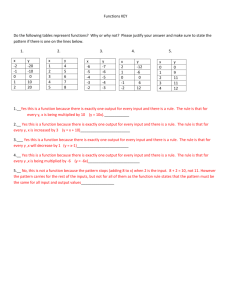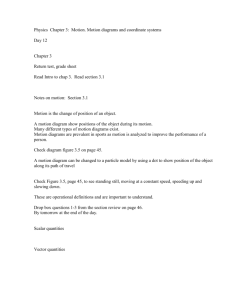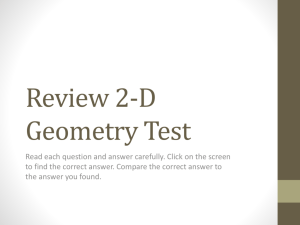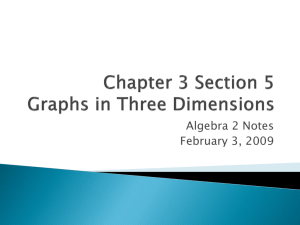lec6
advertisement
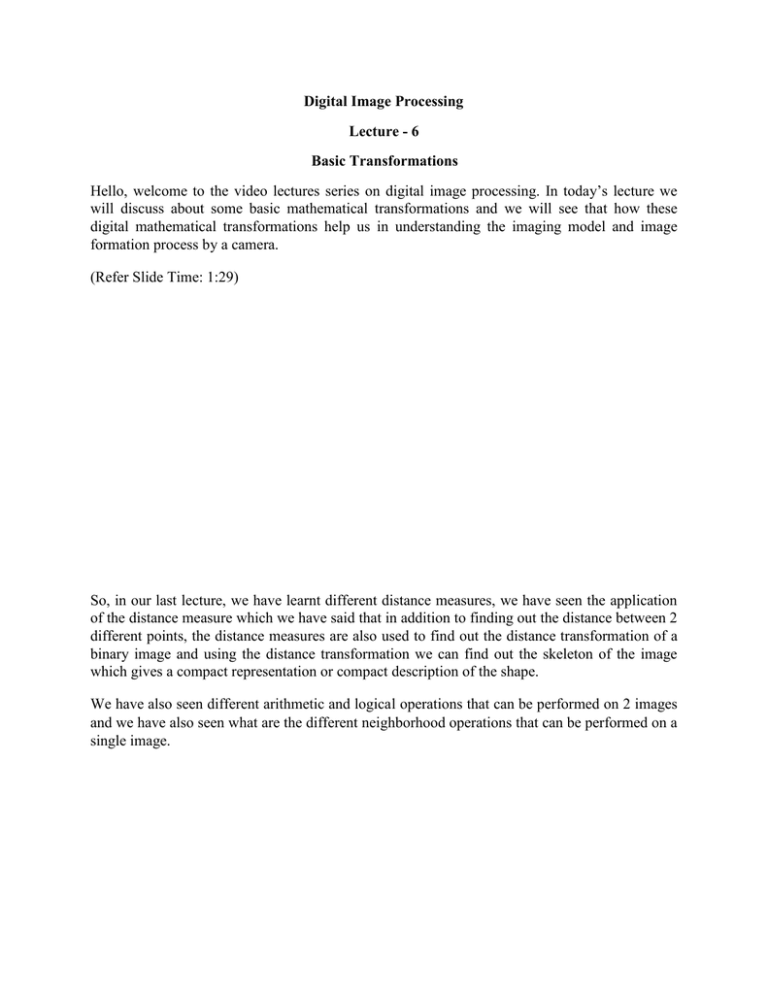
Digital Image Processing Lecture - 6 Basic Transformations Hello, welcome to the video lectures series on digital image processing. In today’s lecture we will discuss about some basic mathematical transformations and we will see that how these digital mathematical transformations help us in understanding the imaging model and image formation process by a camera. (Refer Slide Time: 1:29) So, in our last lecture, we have learnt different distance measures, we have seen the application of the distance measure which we have said that in addition to finding out the distance between 2 different points, the distance measures are also used to find out the distance transformation of a binary image and using the distance transformation we can find out the skeleton of the image which gives a compact representation or compact description of the shape. We have also seen different arithmetic and logical operations that can be performed on 2 images and we have also seen what are the different neighborhood operations that can be performed on a single image. (Refer Slide Time: 2:19) So, in today’s lecture as we said that we will discuss about some basic mathematical transformations which will include translation, rotation and scaling and this we will discuss both in 2 dimension as well as in 3 dimension. We will also discuss about the inverse transformations of these different mathematical transformations. We will find out the relationship between Cartesian coordinate system and homogeneous coordinate system and we will see that this homogeneous coordinate system is very very useful while discussing about the image formations by a camera. We will also talk about the perspective transformation and imaging process and then we will talk about the inverse perspective transformation. (Refer Slide Time: 3:21) Now, coming to the basic mathematical transformations, let us first talk about that what is the translation operation and we will start our discussion with a point in 2 dimensional. So, you know that if I have a 2 dimensional coordinate system given by the axis x and y and if I have a point P which is having a coordinate given by say (x, y) and I want to translate this point P(x, y) by a vector x0 y 0. So, after translating this point by the vector x 0 y0, I get the translate point say at point P prime whose coordinates are x prime and y prime. And because the translation vector in this case we have assumed as x0 y0; so you know that after translation, the new position x prime will be given by x plus x0 and y prime will be given by y plus y0. Now so, this is the basic relation when a point at location xy is translated by a vector x0 y0. Now, let us see that how this can be represented more formally by using a matrix equation. So, if I translation this equation in the form of a matrix, the equation look like this. (Refer Slide Time: 5:07) I have to find out the new location vector x prime y prime and we have said that this x prime is nothing but x plus x0 and y prime is nothing but y plus y 0. So, this particular relation if I represent in the form of a matrix, it will simply look like this. So, you find that if you solve this particular matrix expression, it gives you the same expression x prime equal to x plus x 0 and y prime is equal to y plus y0. So, on the right hand side, you find that I have product of 2 matrices which is added to another column matrix or column vector. (Refer Slide Time: 6:28) Now, if I what to combine all these operation in a single matrix form, then the operation will be something like this - on the left hand side I will have x prime and y prime which will be in the form of matrix and on the right hand side I will have 1, 0 then x 0 0, 1 y0 and then I we will have x y and 1. So, if I again do the same matrix computation, it will be x prime equal to x plus 0 plus x0 which is nothing but x plus x0. Similarly, y prime will be 0 plus y plus y 0 which is nothing but y plus y0. But you find that in this particular case, there is some asymmetry in this particular expression. So, if I want to make this expression symmetric, then I can write it in this form - x prime y prime and I introduce one more component which I make equal to 1, this is equal to 1 0 x0 0 1 y0 than 0 0 1 and x y 1. So, we find that the second expression which I have just obtained from the first one is now a symmetric expression and this is what is called and unified expression. So, we find that basically what I have is I had the original coordinate (x, y) of the point P which is appended with one more component that is given as 1 and if this modified coordinate is now transformed by a transformation matrix which is given as 1 0 x0 0 1 y0 and 0 0 1; then I get the translate point as x prime y prime 1 where if I just neglect the additional component which in this case is 1, then I get the translate point P prime. So, this is about the translation. (Refer Slide Time: 9:14) In the same manner, given a point P again in 2D; so again I have this point P which is having again having a coordinate (x, y) and suppose I want to rotate this point P around the origin by an angle theta. Now, one way of representing this point p is if r is the distance of point P from the origin; then these of coordinates of the point p. This is the x coordinate, this is the y coordinate, I can also represent and suppose this angle it is alpha, then I can also represent x as x equal to r cosine alpha and y equal to r sin alpha. Now suppose, I want to rotate this point P by an angle theta in the clockwise direction; so, the new position of P will now P prime having the coordinate location x prime and y prime and this rotation, angle of the rotation is now angle theta. So, our job is that what will be these points, the coordinate points x prime and y prime? So, here you find that I can write this x prime as r cosine alpha minus theta and I can write y prime as r sin alpha minus theta. (Refer Slide Time: 11:07) So if I simply expand this, so I have x prime is equal to r cosine alpha minus theta and y prime is equal to r sin alpha minus theta. So, if I simply expand this cosine term, it will simple be r cosine alpha cosine theta plus r sin alpha sin theta. Now, we know that r cosine alpha is nothing but x, so it becomes x cosine theta plus r sin alpha is nothing but y, so it becomes y sin theta. Similarly, in this case if I expand this, it becomes r sin alpha cosine theta minus r cosine alpha sin theta. So again, r sin alpha this is nothing but y, so this expression y cosine theta minus x sin theta. So again, so here we find that x prime given by x cosine theta plus y sin theta and y prime is given by minus x sin theta plus y cosine theta. (Refer Slide Time: 12:38) So, even now if I repersent this in the form of an matrix equation, it becomes x prime y prime is equal to cosine theta sin theta, then minus sin theta cosine theta and then I have the original coordinates x and y. So, here you find that if I rotate the point p by an angle theta around the origin in the clockwise direction; in that case, the transformation matrix which gives the rotation transformation is given by this particular matrix which is cosine theta sin theta minus sin theta cosine theta. Now, in the same manner if I go for scaleing, say for example if I have scaling Sx, scaling vector of Sx in the x direction and I have scaling vector S y in the y direction; in that case, the transformation matrix for scaling can also repesented as x prime y prime is equal to S x 0 0 Sy and which is multiplied by the originat coordinate (x, y). So, here you find that the the transformation matrix for performing the scaling operation is nothing but the matrix Sx 0 and 0 S y. So, these are the simple transformation that I can have in 2 dimension. Now, it is also possible to concatenate the transformations. For example, here I have consider the rotation of a point around the origin. Now, if my application demands that I have to rotate the point p around the arbitary point q in the 2 dimention, then find out the expression for this rotation of point p by an angle theta around another point q is not an is easy job, I mean that expression will be quite complicated. So, I can simplify this operation just by translating the point q to the origian and the point P also has to be translated by the same vector and after performing this transformation, the translastion, if I now rotated point p by the same angle theta and now it will be rotation around the origin. So, whatever expression that we have found here that is cosine theta sin theta minus sin theta cosine theta, the same transformation matrix applicable and after getting this rotation, now you translate back the rotated point by the same vector but in the opposite direction. (Refer Slide Time: 15:38) So, here the transformation that we are appling is first we are performing a translation of point P by the vector and after performing this translation, we are performing the rotation. So, this is your the transformation say R theta. So, first we are translating by a vector say r, then we are performing the rotation by vector r theta and after doing this, whatever point I get that has to be translated back by minus r. So, I will put it as translation by the vector minus r. So, this entire operation will give you the rotation of a point p. Suppose, this point p and I want to rotete this arount the point Q; so if I want rotete P arount Q by an angle theta, then this operastion can be performed by concartesian of this translation rotation then followed by inverese tranlastion which puts back the point to its original point where it should have been after rotating around point Q by angle theta. So, these are the different transformations, the basic mathemathcal transformations that we can do in 2 dimensional space. Now, let us see that what will be corresponding transformations if I move from 2 dimentional space to the 3 dimentional space. (Refer Slide Time: 17:19) So, the transformations in the 3D coordinate system that we will consider is translation, rotation and scaling and the coodinated coordinate system that we will consider in this case is 3D dimensional coordinate system. (Refer Slide Time: 17:36) So, first let us see as we have seen in case of 2 dimension that if a point (x, y, z) is translated to new coordinate say (x star, y star, z star) using a displacement vector x 0 y 0 z0; then this translated coordinates x star will be given by x plus x0 y, star will be given by y plus y0 and z star will given by z plus z0. So, you see that in our previous case, we have said that because we had only the coordinates x and y, so this third expression - z star is equal to z plus z0 that was absent. But now we are considering a 3 dimentional space a 3D coordinate system, so we have 3 coordinates x, y and z and all these 3D coordinates, all the 3 coordinate are to be translated by the translation vector x 0 y0 z 0 and then new translation at the new point we get as x star, y star and z star. (Refer Slide Time: 18:56) Now, if I write these 3 equation in the form of a matrix, then the matrix equvation will be like this – (X star, Y star, Z star) on the left hand side will be equal to (1 0 0 x0) (0 1 0 y 0) (0 0 1 Z0) into the column vector (X Y Z 1). So, this is the similar situation that we have also seen in case of 2 dementional that we have to add an additional component which is equal to 1 in our original ah position vector XYZ . So in this case, again we have added the additional component which is equal to 1. So, our next position, our new position vector becomes X Y Z 1 which has to be multiplied with the translation matrix given by (1 0 0 X0) (0 1 0 Y0) and (0 0 1 Z0). So, again as before, we can go for an unified expression where this translation matrix which at this moment is having a dimension 3 by 4. That is it is having 3 rows and 4 columns in unified representations, we will represent this matrix the dimension of matrix will be 4 by 4 which will be a square matrix and the left hand side also will have the same unified coordinate that is (X star Y star Z star 1). (Refer Slide Time: 20:26) So, the unified representation as we have already said is given by (X star Y Star Z star 1) is equal to the translation matrix (1 0 0 X0) (0 1 0 Y0) (0 0 1 Z0) (0 0 0 1) multiplied by the column vector (X Y Z 1). So, this particular matrix that is (1 0 0 X0) (0 1 0 Y0) (0 0 1 Z 0) and (0 0 0 1) this represents a translation a transformation matrix used for the translation and we will represent this matrix by this uppercase letter T. So, that is about the simple translation that we can have. (Refer Slide Time: 21:26) So, in unified matrix representation, we have done that if you have a vector V, a position vector V which is translated by the transformation matrix A, the transformation matrix A is a 4 by 4 transformation matrix; the V if the original position vector was X, Y, Z, we have added and additional component 1 to it in our unified matrix representation. So, V now becomes a 4 dimensional vector having components X, Y, Z and 1. Similarly, the transformed position vector V star is also a 4 dimensional vector which is having components X star, Y star, Z star and 1. So, this is how in the unified matrix representation, we can represent the translation of a position vector or a translation of a point in 3 dimension. (Refer Slide Time: 22:28) Similarly, we can have so as I said that this is the transformation matrix which is represented, which is used for translating a point in point 3D by vector X 1 Y X0 Y0 Z0 or the displacement vector X0 Y0 Z0. (Refer Slide Time: 22:49) Similarly, as we have seen in case of scaling in 2 dimension that if we have the scaling factor of Sx Sy and Sz along the directions x, y and z; so along direction x, we have the scaling factor S x, along the direction y, we have the scaling factor Sy and along the direction z, we have the scaling factor Sz, then the transformation matrix for this scaling operation can be written by S equal to Sx 0 0 0, then 0 Sy 0 0, then 0 0 Sz 0 then 0 0 0 1. So, here again, if you find you, find that a position vector X Y Z in unified form it will be (X Y Z 1) if that position vector is translated by this scaling matrix, then what we get is the new position vector corresponding to point (X Y Z 1) in the scale form and there if we remove the last component that is equal to 1, what we get is the scaled 3D coordinate of the point which has been scaled up or scaled down. So, it will be scaling up or scaling down depending upon whether the value of the scale factors is greater than 1 or they are less than 1. (Refer Slide Time: 24:22) Then coming to rotation, we have seen that the translation and scaling in 3 dimensions is very simple, it is as simple as we have done in case of 2 dimensions. But the rotation in 3 dimension is a bit complicated because in 3 dimension, as we have 3 different axis - x axis, y axis and z axis; so, when I rotate a point around origin by certain angle, the rotation can be around x axis, the rotation can y axis, the rotation can be also be around z axis. So accordingly, I can have 3 different rotation matrixes for representing rotation around a particular axis and specifically, if the rotation as to be done about an arbitrary point; then what we have to do is we had to translate the arbitrary point to the origins by using the translation transformation. After translating the point to the origin, then we have to perform rotation around the origin, then we have to translate back the point to its original position. So, which gives us the desired rotation of any point p in 3D around any other arbitrary point Q also in 3D. (Refer Slide Time: 25:46) So, now let us see that how this rotation will look like in 3D. So, here you find that we have shown on the right hand side, this particular figure where this figure shows the rotation of the point along x axis. So, if the point is rotated along x axis, the rotation is given by is indicated by alpha. If it is rotated along z axis, the rotation is indicated by theta and if the rotation is done along y axis, the rotation angle is indicated by beta. So, if I rotate the point along z axis; so when I am rotating a point along z axis, then obviously the z coordinate of the point will remain unchanged even in the rotated position. But what will change is the x coordinate and y coordinate of the point in its new rotated position. And because the z coordinates is remaining unchanged, so we can think that this is a rotation on a plane which is parallel to the xy pair. So, the same transformation which we have done for rotating a point in 2 dimensions in the (x, y) coordinate, the same transformation matrix holds true for rotating this point in 3 dimension along the axis z. But know because the number of components in our position vector is more, we have to take care of the other components as well. So using this, you find that when I rotate the point around z axis, the rotation angle is given by theta and the rotation matrix is given by cosine theta sin theta 0 0, minus sin theta cosine theta 0 0, then 0 0 1 0 and 0 0 0 1. So, this is the transformation matrix or rotation matrix for rotating a point around z axis. So, here you find that the first few components that is cosine theta sin theta, then minus sin theta and cosine theta; so this 2 by 2 matrix is identical with the transformation matrix or rotation matrix that we have obtained in case of 2 dimensions. So, this says that because the z coordinate is remaining the same, so the x coordinate and the y coordinate due to this rotation around z axis follows the same relation that we have derived in the case of 2 dimensions. Similarly, when I translate the point around y axis where the rotate the point around y axis, there angle of rotation is given by beta. So, R beta as given in this particular case, gives you the rotation matrix and if you rotate the angle around the x axis where the rotation angle is given by alpha, you find that R alpha gives you the corresponding rotation matrix along the corresponding transformation matrix for rotation along the x axis. So as before, here you find that when you rotate the point along around the x axis, the x coordinate will remind the same. Whereas, the y coordinate and the z coordinate of the point is going to differ. Similarly, when you rotate the point around y axis, the y coordinate is going to remain the same but x coordinate and z coordinate, they are going to be different. (Refer Slide Time: 29:45) Now, as we have also mentioned in case of 2 dimensions that different transformations can be concatenate. So, here we have shown that say how we can concatenate the different transformations. Here, you find that all the transformations that we have considered in 3 dimensions, all of them are in the unified form. That is every transformation matrix is a 4 by 4 matrix and all the coordinates that we consider, we add 1 to the coordinate X Y Z so that our position vector become a 4 dimensional vector and the translated point is also a 4 dimensional vector. So, if I want to concatenate this different transformation that is translation, scaling and rotation and if I want to rotate a point about Z axis; then this translations, scaling and rotation, this can be concatenated as first you translate the point V by the translation operation T of the translation matrix T, then you perform scaling, then you perform rotation and this rotation is R theta and all these 3 different transformation matrix that is R theta, S and T all of them being 4 dimension matrix can be combined into a single matrix say the single transformation matrix in this case, A which is nothing but the product of R theta, S and T and this A again will be a matrix of dimension 4 by 4. Now, you note that whenever we are going for concatenation of transformations, the order in which these transformations are to be applied, that is very very important because these matrix operations are in general not commutative. (Refer Slide Time: 31:51) Now, just to illustrate that this matrix operations are not commutative, let us take this example. Suppose, I have this particular point V and to this point V, I want to perform 2 kind of operation. One is translation by vector, so the translations vector we have represented by this arrow by which this point has to be translated and the point V is also to be rotated by certain angle. Now, there are 2 ways in which these 2 operations can be done. The first one shows that suppose I rotate point V first by using the operation RV. So, here the transformation matrix is A R for the rotation operation and after rotating this point V by using this transformation R, I translate the rotated point by using the transformation matrix T. So, if I do that, you find that this V is the original position of this point. If I first rotate it by using this rotation transformation, the point V comes here in the rotated position and after this if I give the translation to this point V by this translation vector, then the translated point is coming over here which is represented by V2. So, the point V2 is obtained from V first by applying the rotation by transformation R followed by applying the translation by the transformation T. Now, if I do it reverse that is first I translate the point V using this translation transformation T and after this translation, I rotate this translated point which now Tv by the same angel theta; so what I do is first I translate the point using the transformation T and after that this translated point is rotated by using the rotation transformation R and this gives me the rotated point or the new point that is equal to V1. Now, from here you find that in the earlier case where in I got the point V2 and now I get the point V1. This V1 and V2, they are not the same point. So, this clearly illustrates that whenever we go for concatenation of different transformations, we have to be very very careful about the order in which this transformations are to be specified or to the transformations are to be applied because if the order in which the transformations are applied vary, then we are not going to get the same end result. So, for any such concatenation, the order in which the concatenation is applied the transformations are applied that has to be thought of very very careful. (Refer Slide Time: 35:23) So, that is about translation of the transformation of a single point. Now, if I have to transform a set of points; say for example, I can have a square figure which, say it is like this, say for example, in a 2 dimensional space X Y, I have the square figure like this. (Refer Slide Time: 35:42) So, this will have 4 vertices, the vertices I can represent as point P1, point P2, point P 3 and point P4. Now, so far the transformations that we have discussed, that is the transformation of a single point around origin or the transformation of a single point around another arbitrary point in the same space. Now here, if I have to transform to this entire figure, that is for example, I want to rotate this entire figure about the origin or I want to translate this entire figure by certain vector say V, so say for example I want to translate the entire figure to this particular position; so you find that here all this points P1, P2, P3 and P 4 all these points are going to be translated by the same displacement vector V. So, it is also possible that we can apply transformation to all the points simultaneously, rather than applying transformation to individual points 1 by 1. So, for a set of m points, what we have to do is we have to construct a matrix V of a dimension 4 by m. That is every individual point will now be considered, of course in the unified form, will now be consider as a column vector of this matrix which is of dimension of 4 by m. And then, we have apply the transformation A to this enter matrix and the transformation after this transformation, we get the new matrix V star which is given by the transformation A multiplied by the B. So, you have find that any particular columns, i’th columns in the matrix in the Vi V star which is a Vi star is the transformed point corresponding to the i’th column of matrix B which is represented Vi. So, if I have a set of points which are to be transformed by the same transformation, then all those points can be arranged in the form of columns of a new matrix. So, if I have n number of points, I will have a matrix having m number of columns. The matrix will also obviously have 4 rows and this new 4 by m matrix that I get, this entire matrix has to be transformed using the same transformation operation and I get the transformed points again in the form of a matrix and from that transform matrix, I can identify that which point which is the transformed point of the original points. (Refer Slide Time: 38:59) Now, once we get these transformations, again we can get the corresponding inverse transformation. So, the inverse transformations, in most of the cases can be obtained just by observations. Say for example, if I apply if I translate a point by a displacement vector V, then inverse transformation should bring back that translated point that transformed point to its original position. So, if my translation is by a vector V, the inverse transformation or the inverse translation should be by a vector minus V. So, the inverse transformation matrix T inverse can be obtained as (1 0 0 minus X0) (0 1 0 minus Y0) (0 0 1 minus Z0) then (0 0 0 1). So, you remember that the corresponding transformation matrix that we said was (1 0 0 x0) (1 0 0 (0 1 0 Y0) (0 0 1 Z0) and (0 0 0 1). So, we find that X0 Y0 and Z0, they have just been negated to give you the inverse translation matrix T inverse. So similarly, by the same observation, we can get inverse rotations R theta inverse where what we have to do is in the transformation matrix original rotation matrix, we have the term cosine theta sin theta minus sin theta cosine theta; now, all this thetas are to be replace by minus theta which gives me the inverse rotation matrix around the Z axis. (Refer Slide Time: 40:45) Similarly, we can also find out the inverse matrix for scaling where the S x will be replaced by 1 upon Sx. So, these are the basic transformation, basic mathematical transformations. Now, we will see another form of transformation which is called a perspective transformation. Now, this perspective transformation is very very important to understand how a point in the 3 dimension in the 3D world is imaged by a camera. So, this perspective transformation is also known as an imaging transformation and the purpose of this imaging transformation is to project a 3D point, a 3D world point into the image plane and this gives an approximation to the image formation process which is actually followed by a camera. Now, let us see what is this perspective transformation. (Refer Slide Time: 41:49) Here, we have shown a figure which is an approximation of the image perform image formation process. Here, you find that we have 2 coordinate systems which as a superimposed one over the other. One is the 3D world coordinate system represented by capital X, capital Y, capital Z. So, this is the 3D world coordinate system capital X capital, Y and capital Z and I also have the camera coordinate system which is given by lowercase x, lowercase y and lowercase z. Now, here we have assumed that this camera coordinate system and the 3D world coordinate system, the perfectly aligned. That is x axis of the 3D world coordinate systems coincides with the x axis of the camera coordinate system, y axis of the world coordinate system coincides with the y axis of the camera coordinate system. Similarly, Z axis of the world coordinate system coincides the Z axis of the camera coordinate system. So, they have, both this coordinate systems have the same origin. Now, if I have a point X, Y, Z in 3D; so this is the point XYZ in 3 dimension and I have assume that the center of the lens is at location 0 0 lambda; so obviously, the lambda which is the Z coordinate of the lens center, this also nothing but the focal length of the camera and this X, Y, Z this particular 3D point, we are assume that it is mapped to the camera coordinate given by lowercase x and lowercase y. Now, our purpose is that if I know this 3D coordinate system - capital X, capital Y, capital Z and I know the value of lambda that is the focal length of the camera whether it is possible to find out the coordinate, the image coordinate corresponding to this 3D world coordinate X, Y, Z. (Refer Slide Time: 44:31) So to this, we apply the concept of similar triangles. So here, what we do is by using the similar triangles we can find out an the expression that lowercase x by lambda is equal to minus capital X by capital Z minus lambda which is nothing but capital X by lambda minus Z and y by lambda is in the same manner is given by capital Y by lambda minus capital Z. So from this, I can find out that the image coordinates of the 3D world coordinate capital X capital Y, capital Z is given by x coordinate x inverse coordinate x is given by lambda x by lambda minus capital Z. Similarly, the inverse coordinate y is given by lambda capital Y divided by lambda minus capital Z. Now, these expressions also can be represented in the form of the matrix and here we find that if I go for homogeneous coordinate system, then this matrix expression is even simpler. (Refer Slide Time: 45:44) So, let us see what is this homogeneous coordinate system. Homogenous coordinate system is if I have the Cartesian coordinate capital X, capital Y capital Z; then we have said that in unified coordinate system, we just append a value 1 as an additional component. Homogeneous coordinate system is instead of simply adding 1, we add an arbitrary non 0 constant say k and multiply all the coordinated X, Y and Z by the same value k. So, given the Cartesian coordinate, capital X capital Y capital Z; I can convert this to homogenous coordinate by k times capital X, k times capital Y and k times capital Z. The inverse process is also very simple that if I have a homogenous coordinate, then what have to do is I have to divide all the components of the homogenous coordinate by the fourth term. So, in this case the fourth term is k and all the other terms where kX, kY and kZ; so if I divided all this 3 terms by the fourth component k, I get the Cartesian coordinate X Y Z. So, I can convert a 3D point, the coordinates from the Cartesian coordinate system to the homogeneous coordinate system and I can also very easily convert from homogenous coordinate from homogenous coordinate system to Cartesian coordinate system. (Refer Slide Time: 47:24) Now, to understand the imaging process, let us defined a perspective transformation which is given by P equal to (1 0 0 0) (0 1 0 0) then (0 0 1 0) then (0 0 minus 1 upon lambda). You remember, this lambda is focal length of the camera and then 1 and we translate our world coordinate W to the homogeneous coordinates; so, it becomes kX, kY, kZ and k. Now, if I translate if I transform this homogenous world coordinate by this perspective transformation matrix P, then I get the homogenous camera coordinates Ch which is given by kX, kY, kZ then minus k into Z by lambda plus k. So, this is the homogeneous camera coordinate. Now, if just convert this homogenous coordinate camera coordinate to the Cartesian camera coordinate, I find that the Cartesian camera coordinate is given by C equal to small x, small y small z which is nothing but lambda X divided by lambda minus Z, lambda Y divided by lambda minus Z and lambda Z divided by lambda minus Z. So, in the right hand side, this x, y, z they are all in uppercase indicating those are the coordinate of the world point. (Refer Slide Time: 49:05) Now, if I compare this expression with the camera coordinate that we have obtained with respective our previous diagram, you find that here we get lowercase x is nothing but lambda capital X divided by lambda minus Z. Similarly, lowercase y is also nothing but lambda capital Z by lambda minus Z. So, using our previous diagram, we have also seen that these lowercase x and lowercase y, they are the image point on the image plane of the world coordinate - capital X, capital y and capital Z. So, this shows clearly that using the perspective transformation that we have defined as the matrix p; I can find out the image coordinates of world coordinate point capital X, capital Y capital Z following this particular transformation P. Now, here in this particular case, the third component that we have obtained that is the value of Z which is not importance in our case because in the camera coordinate, the value of Z is always equal to 0 because we are assuming that the imaging plane is the X Y plane of the world coordinate system as well as the camera coordinate system. So, we will stop our discussion here today and the next class, we will see that as we have seen that with the perspective transformation; we can transform a world coordinate, we can project a world point, a 3D world point onto an imaging plane similarly using the inverse perspective transformation; whether it is possible that given a point in inverse plane whether we can find out the corresponding 3D point in the 3D world coordinate system.


